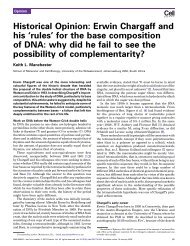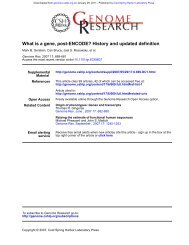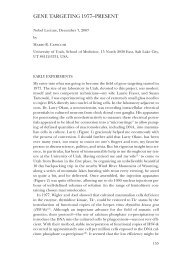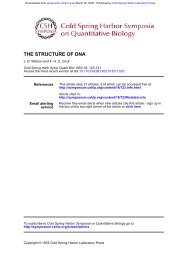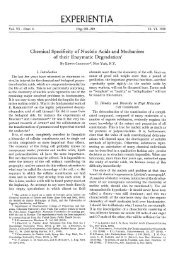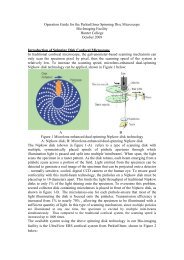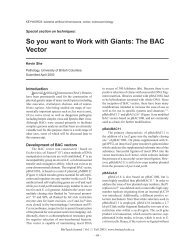Chargaffs Legacy.pdf - Biology
Chargaffs Legacy.pdf - Biology
Chargaffs Legacy.pdf - Biology
- No tags were found...
You also want an ePaper? Increase the reach of your titles
YUMPU automatically turns print PDFs into web optimized ePapers that Google loves.
134D.R. Forsdyke, J.R. Mortimer / Gene 261 (2000) 127±137At the molecular level, we see similar forces acting at thelevel of meiosis. Here paternal and maternal chromosomalhomologs align. Forsdyke has proposed that if there is suf®cientsequence identity, so that the DNA `dialects'[(C 1 G)%] match, meiosis is likely to progress throughvarious check-points (Page and Orr-Weaver, 1996), andgametes will be formed. If there is insuf®cient identity (i.e.the DNA `dialects' do not match) meiosis will fail, gameteswill not form, and the individual will be sterile, ± a `mule'.Thus, the original parental lines will be reproductivelyisolated from each other, and as such would be de®ned asdistinct species. Changes in the (C 1 G)% dialects have thepotential to initiate speciation (Forsdyke, 1996b).9. The unpairing postulateMuller (1922) suggested that the pairing of genes as partsof chromosomes undergoing meiotic synapses, mightprovide clues to gene structure and replication:ªIt is evident that the very same forces which causethe genes to grow should also cause like genes toattract each other, ¼If the two phenomena are thusdependent on a common principle in the make-up ofthe gene, progress made in the study of one of themshould help in the solution of the other.ºIn 1954 he set his students an essay `How does theWatson-Crick model account for synapsis?' (Carlson,1981). Crick (1971) took up the challenge with his `unpairingpostulate' by which the two strands of the classical DNAduplex would unpair to allow a homology search.Recent work on the meiotic alignment of chromosomessuggests that initiation of speciation involves that aspect ofthe genome phenotype (reprotype), which is constituted bythe genome-wide potential to extrude stem-loops. Those ofthe maternal and paternal chromosomal homologs maymutually explore each other and test for `self' DNA complementarity,using the `kissing' mechanism of Tomizawa(Eguchi et al., 1991; Hawley and Arbel, 1993; Kleckner,1997). If suf®cient complementarity is found (i.e. thegenomes are reprotypically compatible), then crossingover and recombination can occur. The main adaptivevalue of this would be to provide for the correction of errorsin the individual homologs (Winge, 1917; Bernstein andBernstein, 1991).Where does the (C 1 G)% `dialect' come into this? It hasbeen observed that small ¯uctuations in (C 1 G)% wouldhave a major effect on the ability of duplex DNA moleculesto extrude stem-loops and on the pattern of loops which thenoccur. A very small difference in (C 1 G)% (reprotypicdifference) would mark a meiotically pairing DNA as`not-self'. This would impair the kissing interaction with`self' DNA (Forsdyke, 1998; Bull et al., 1998), and sowould disrupt meiosis and allow divergence between thetwo parental lines, thus initiating speciation (Forsdyke,1996b). Consistent with this, direct tests of incipient speciationin the fruit ¯y (the phenomenon known as Haldane'srule) implicate differences in DNA per se, rather than indistinct genes, as initiating reproductive isolation (Naveiraand Maside, 1998; Forsdyke, 2000a). Similar considerationsmay apply to the phenomenon of `heteroduplex resistance'between recombining DNAs of different bacterial species(Majewski and Cohan, 1998).Once a speciation process has begun, prezygotic factorsand postzygotic factors other than (C 1 G)% are likely toreplace the original difference in (C 1 G)% as a barrier toreproduction (i.e. a barrier to recombination). In thiscircumstance, (C 1 G)% becomes free to adopt otherroles, such as the prevention of intragenomic recombination.This could involve intragenomic differentiation ofregions of high and low (C 1 G)% (isochores). Thesehave the potential to `reproductively isolate' (i.e. recombinationallyisolate) different parts of the genome. Thus, theattempted duplication of a globin gene into a-globin and b-globin genes might have failed since sequence similaritywould favour recombination between the two genes andany incipient differences would be eliminated. However,the duplication appears to have involved relocation to adifferent isochore with corresponding changes in(C 1 G)%, so that the two genes became recombinationallyisolated. As a consequence of the differences in (C 1 G)%the corresponding mRNAs utilize different codons for correspondingamino acids, even though both mRNAs are translatedin the same cell using the same ribosomes and tRNAFig. 3. Summary of potentially con¯icting evolutionary pressures as manifestat the level of mRNA (dark line with arrow-head). (1) (C 1 G)%pressure (`GC pressure') acting primarily at the genomic level, and secondarilyaffecting mRNA base composition. (2) Fold (stem-loop) pressureacting primarily at the genomic level and secondarily affecting mRNAbase order. (3) Purine pressure acting primarily at the cytoplasmic levelto enrich loops with purines. (4) Coding pressure deriving from classicalenvironmental interactions with the conventional phenotype, which resultin base changes in the protein-encoding part of the mRNA. (5) Regulatorypressures (small grey boxes) acting primarily at the cytoplasmic level,which result in base changes mainly in the 5 0 and 3 0 non-coding regions.



